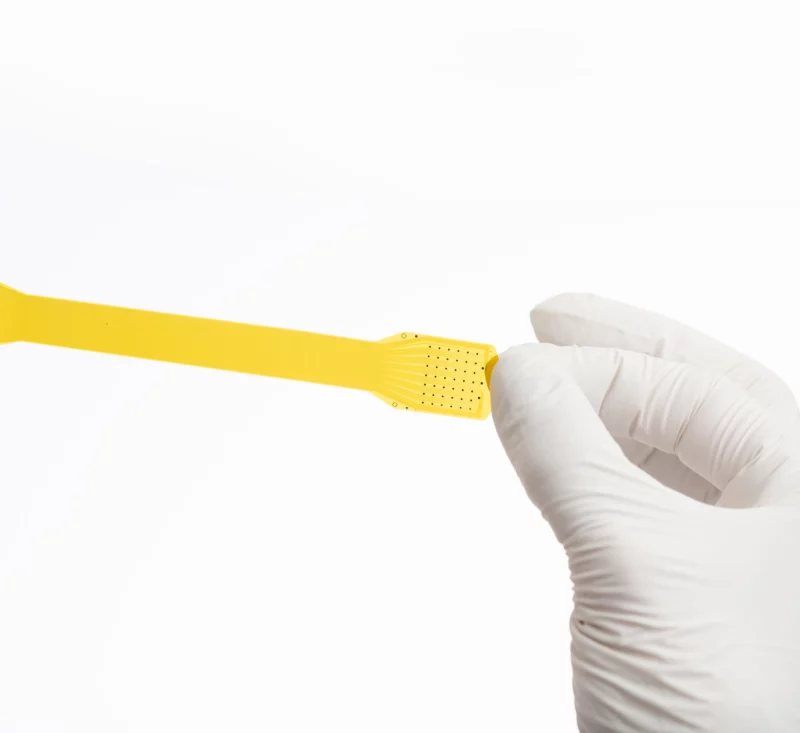
Brain-computer interface company Precision Neuroscience says that it has set a new world record for the number of neuron-tapping electrodes placed on a living human’s brain—4,096, surpassing the previous record of 2,048 set last year, according to an announcement from the company on Tuesday.
The high density of electrodes allows neuroscientists to map the activity of neurons at unprecedented resolution, which will ultimately help them to better decode thoughts into intended actions.
Precision, like many of its rivals, has the preliminary goal of using its brain-computer interface (BCI) to restore speech and movement in patients, particularly those who have suffered a stroke or spinal cord injury. But Precision stands out from its competitors due to a notable split from one of the most high-profile BCI companies, Neuralink, owned by controversial billionaire Elon Musk.
Precision was co-founded by neurosurgeon and engineer Ben Rapoport, who was also a co-founder of Neuralink back in 2016. Rapoport later left the company and, in 2021, started rival Precision with three colleagues, two of whom had also been involved with Neuralink.
In a May 3 episode of The Wall Street Journal podcast The Future of Everything, Rapoport suggested he left Neuralink over safety concerns for the company’s more invasive BCI implants.
To move neural interfaces from the world of science to the world of medicine, “safety is paramount,” Rapoport said. “For a medical device, safety often implies minimal invasiveness,” he added. Rapoport noted that in the early days of BCI development—including the use of the Utah Array—”there was this notion that in order to extract information-rich data from the brain, one needed to penetrate the brain with tiny little needlelike electrodes,” he said. “And those have the drawback of doing some amount of brain damage when they’re inserted into the brain. I felt that it was possible to extract information-rich data from the brain without damaging the brain.” Precision was formed with that philosophy in mind—minimal invasiveness, scalability, and safety, he said.
Neuralink’s current BCI device contains 1,024 electrodes across 64 thinner-than-hair wires that are implanted into the brain by a surgical robot. In the first patient to receive an implant, the wires were inserted 3 millimeters to 5 mm into the brain tissue. But, 85 percent of those wires retracted from the patient’s brain in the weeks after the surgery, and some of the electrodes were shut off due to the displacement. Neuralink is reportedly planning to implant the wires deeper—8 mm—in its second patient. The Food and Drug Administration has reportedly given the green light for that surgery. The Utah Array, meanwhile, can penetrate up to 1.5 mm into the brain.
Precision’s device does not penetrate the brain at all, but sits on top of the brain. The device contains at least one yellow film, said to be a fifth the thickness of a human hair, that contains 1,024 electrodes embedded in a lattice pattern. The device is modular, allowing for multiple films to be added to each device. The films can be slipped onto the brain in a minimally invasive surgery that requires cutting only a thin slit in the skull, which the yellow ribbon-like device can slide through, according to Precision. The film then conforms to the surface of the brain. The processing unit that collects data from the electrodes is designed to sit between the skull and the scalp. If the implant needs to be removed, the film is designed to slide off the brain without causing damage.
In April, a neurosurgery team from the Mount Sinai Health System placed one of Precision’s devices containing four electrode-containing films—totaling 4,096 electrodes— onto the brain of a patient who was having surgery to remove a benign brain tumor. While the patient was asleep with their skull was opened, Precision researchers used their four electrode arrays to successfully record detailed neuronal activity from an area of approximately 8 square centimeters of the brain.
“This record is a significant step towards a new era,” Rapoport said in a press release Tuesday. “The ability to capture cortical information of this magnitude and scale could allow us to understand the brain in a much deeper way.”
The test of the implant marks the 14th time Precision has placed its device on a human brain, according to CNBC, which was present for the surgery in New York. Precision says that it expects to have its first device on the commercial market in 2025.
